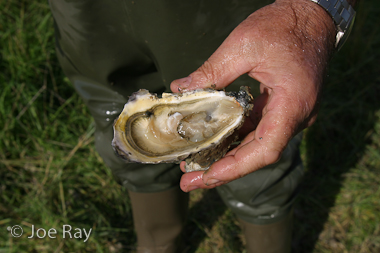Master of Seafood
April/May 2009 - Paris Magazine

PARIS—Jacky Lorenzo’s skill as a fishmonger is evident in his hands – strong, stubby and worn, each one as much of a tool as a fillet knife. Combine this with a lifetime of product knowledge and it’s easy to understand why, for discriminating chefs and demanding clients, Lorenzo is the most sought-after poissonnier at the street markets of Paris.
“I even sold sole and monkfish to the Pope when he was here,†he recalls. Technically, he sold to someone on Benedict XVI’s staff, but the word from on high is that the Pontiff likes monkfish.
Lorenzo’s is the story of the open-air markets of Paris for the last 30 years. “I used to empty trucks at Les Halles,†he says, referring to the giant wholesale food market that dominated the center of Paris for more than 800 years before being replaced by the Rungis market in the Paris suburbs. “I learned when you’re hauling stuff around to make sure you get paid first!â€
Lorenzo got his start in the 1970s, moving from the Loire Valley to Levallois-Perret, where he learned the fishmonger trade for six years. In 1977, he bucked the trend and opened one of the first high-end fish stands in the Paris street markets.
Knowing how to buy
“There were only cheap fish on the street stands then. People weren’t used to being able to get the good stuff,†he says, “but we’d buy a 250-kilo sword- fish and have no trouble getting rid of it all.â€
Now, dozens of top-quality fish and shellfish are on mouth-watering display at his stand at the Bastille, Popincourt and PreÌsident Wilson markets. Square salmon filets are arranged skin-up, skin-down next to one another, creating a silver and orange checkerboard; king crab sit atop mountains of shellfish, and cooked prawns fan out over the ice.
But presentation is only the tip of the iceberg. Lorenzo’s real skills lie in his product knowledge and sourcing ability. “In Paris, tuna starts in May – that’s the season when it’s running in both the Mediterranean and the Atlantic. In June, there’s French sole from Dunkirk,†he says, reeling off a couple of seasonal examples.
Knowing how to buy is just as important as what he purchases.“When I buy, it’s at Rungis,†he says, quickly dispatching the idea that the best fish in Paris is bought off the back of the boat. “I tried buying it at the seaside, but all the best stuff is set aside for Rungis.â€
Lorenzo makes a point of trolling the gigantic market at 1:30 am, even though the doors don’t officially open until 2:00 am. “I have buy- ers who take care of me, but you’ve gotta get there early to get la creÌ€me,†he says. “In fish, you’ve got to be the first one to Rungis and be good at sourcing. I make a swing around the market to see what’s there, but if I find a belle pieÌ€ce, I buy it right away. If I don’t grab it, somebody else will.â€
Looking for good deals
That said, if there’s an exceptional piece at a price that might scare some of his competitors away, he’s ready to plunk down the euros to get it. “I take risks and don’t hesitate to pay a lot for a big piece of fish, but at the end of the day, you’ve got to have the turnover to be able to sell it all.â€
Unlike some other fishmongers, he also makes the extra effort of going to Rungis every day. “Young guys will just order over the phone,†he says, “but if I don’t see it, I don’t
buy it.â€
Lorenzo is also on the lookout for good deals to pass on to his clients. “If I find scallops from Quiberon for eight or nine euros and scallops from Normandy for five or six, I’ll still take the ones from Quiberon. They taste better, and the small difference in price doesn’t make up for the difference in quality. But if the scallops from Normandy are two or three euros, I’ll take them and pass the discount on to my clients. That’s how I keep them. If people get a good price for fish, they come back. Eighty percent of my clients are regulars.â€
Rare as hen’s teeth
Lorenzo also counts some of Paris’ most demanding restaurant chefs among his faithful customers. “Very simply, Jacky’s one of the best,†says Alain Plaud, owner of the seafood restaurant Les Portes.
But even for Lorenzo, being a fishmonger isn’t easy; fish stocks are declining around the world. “In the last three or four years, it’s become a lot harder to get the
fish we want,†he says. “They’re more expensive and the quality isn’t as good because processing machines now do the work that people used to do.†Finding good labor is also a huge problem. It’s hard to train and retain people who want to sling fish for a living, and he knows the value of what he’s got. Along with his son Fabrice, one of Lorenzo’s most important employees is Maxime Felen, the commis, whose job it is to skin and fillet the fish.
“Guys this good are as rare as hen’s teeth,†Lorenzo says. “I’m very demanding. My stuff is expensive, so I can’t tolerate mistakes. No bits of skin and no bones in a filet. I go crazy when that happens.
“You’ve gotta love this job,†he concludes. “When someone succeeds in this business, it’s because they like their work. Everybody’s struggling in this economy, but the pros will survive.â€
Poissonnerie Jacky Lorenzo
MarcheÌ Popincourt
Bd Richard Lenoir between rues Oberkampf and Jean-PierreTimbaud
75011 Metro:Oberkampf
Tuesday and Friday, 8 am – 1pm
MarcheÌ Bastille
Bd Richard Lenoir between rues Amelot and SaintSabin,
75011
Metro:Bastille Thursday,8am–1pmandSunday,8am–2pm
MarcheÌ PreÌsident Wilson
Av. du Pdt Wilson between rue Debrousse and Placed’IeÌna
75016 Metro:Alma-Marceau, IeÌna
Wednesday and Saturday, 8 am – 1:30 pm